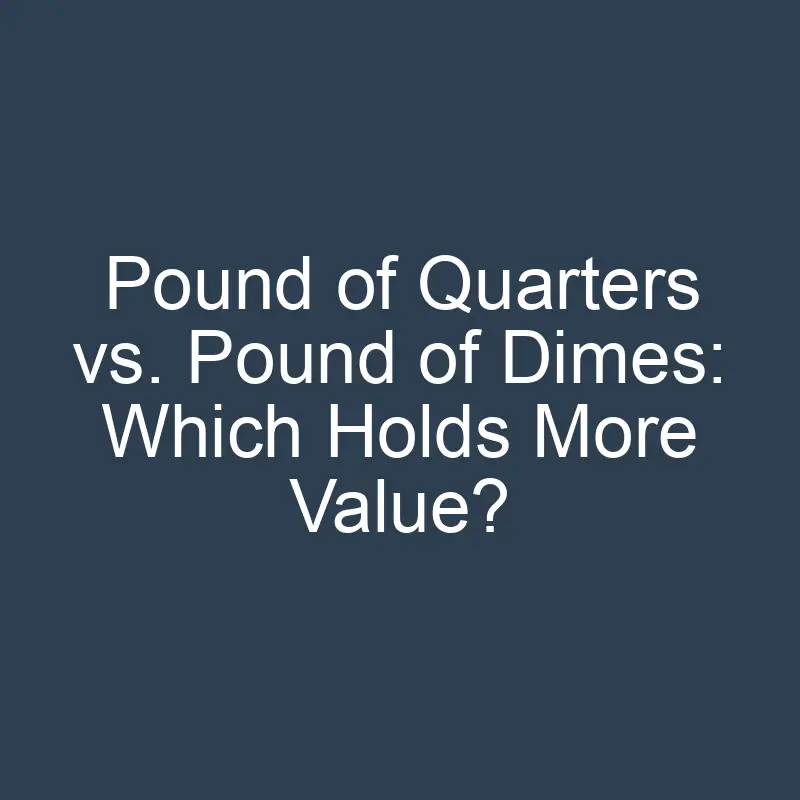
Ever wondered if a pound of quarters is more valuable than a pound of dimes? We’ve all heard the saying “a penny for your thoughts,” but what about a pound for your coins? Let’s dive into the world of currency and explore which pack more punch – quarters or dimes.
In our quest to unravel this age-old question, we’ll break down the value of each coin and weigh the pros and cons. From the weight of the coins to their actual worth, we’ll leave no stone unturned in our investigation. So, grab your magnifying glass and join us on this intriguing journey to uncover the truth behind the value of a pound of quarters versus a pound of dimes.
Weight of Quarters vs. Dimes
When comparing the weight of quarters versus dimes, it’s essential to consider that quarters weigh in at 5.67 grams, while dimes tip the scales at 2.268 grams. This significant difference in weight between the two coins directly impacts the total count within a pound.
In a pound of quarters, you would have approximately 80 coins, due to their higher weight compared to dimes. On the other hand, a pound of dimes would contain roughly 180 coins, given their lighter weight per coin.
The weight of the coins not only plays a role in the physical heaviness of a pound but also influences the total value contained in each pound. Next, we explore the worth of a pound of quarters versus a pound of dimes.
Value of Quarters vs. Dimes
When comparing the value of a pound of quarters to a pound of dimes, it’s essential to consider the denomination of each coin. Quarters have a face value of $0.25 each, while dimes have a face value of $0.10. This means that quarters are worth more than dimes individually.
In a pound of quarters, there are about 80 quarters. Multiplying 80 by the face value of each quarter ($0.25) gives us the total value of a pound of quarters:
| Quarters per Pound | Value per Pound |
|---|---|
| 80 | $20 |
On the other hand, in a pound of dimes, you would find approximately 180 dimes. Calculating the total value of a pound of dimes by multiplying 180 by the face value of each dime ($0.10) gives us:
| Dimes per Pound | Value per Pound |
|---|---|
| 180 | $18 |
a pound of quarters is worth more than a pound of dimes when considering face value alone. This difference in value is a crucial factor to keep in mind when handling and assessing the monetary worth of different coins.
Composition of Quarters and Dimes
When examining the Composition of Quarters and Dimes, it’s essential to understand the intricate details that set these two coins apart. Quarters are larger in size compared to dimes, with a diameter of 24.26mm and a thickness of 1.75mm, while dimes have a smaller diameter of 17.91mm and a thickness of 1.35mm. This difference in size contributes to the variation in weight between the two coins.
Quarters are composed of copper (91.67%) and nickel (8.33%), giving them a distinctive silver appearance. On the other hand, dimes are made of copper (91.67%) and nickel (8.33%) but are smaller in size, which also affects their overall weight. Understanding the composition of these coins provides insight into their durability and resistance to wear and tear over time.
Analyzing the design elements of quarters and dimes also sheds light on their unique characteristics. Quarters feature George Washington on the obverse (front) side and an eagle on the reverse (back) side. In contrast, dimes showcase Franklin D. Roosevelt on the obverse and a torch, olive branch, and oak branch on the reverse, symbolizing liberty, peace, and strength.
Overall, the composition of quarters and dimes contributes to their distinct appearance, weight, and durability, making each coin unique in its own right.
Pros and Cons of Using Quarters and Dimes
When it comes to which is worth more – a pound of quarters or a pound of dimes, there are several factors to consider. Let’s dive into the pros and cons of using these two types of coins:
Quarters
Pros:
- Larger in size
- Easier to handle and count due to size
- More commonly used in vending machines and laundry facilities
- Versatile for various transactions
Cons:
- Heavier to carry in bulk
- Not as convenient for smaller purchases
- Can take up more space in wallets or coin pouches
Dimes
Pros:
- Smaller and lighter in weight
- Ideal for making precise change
- Fit well in coin wrappers for banking purposes
- Useful for everyday, small transactions
- Can be easily lost due to size
- Less commonly accepted in vending machines
Key Takeaways
- Quarters are heavier coins compared to dimes, resulting in fewer coins per pound but higher individual value.
- A pound of quarters is worth $20, while a pound of dimes is worth $18 based on face value.
- Quarters are larger and made of copper (91.67%) and nickel (8.33%), while dimes are smaller and also composed of copper (91.67%) and nickel (8.33%).
- Quarters are more versatile but heavier, while dimes are lighter, ideal for small transactions, but easier to lose.
- Understanding the weight, value, composition, and pros/cons of quarters and dimes helps in assessing their monetary worth and practical usage.
Conclusion
Considering the differences between quarters and dimes in size, weight, and practicality, we have gained valuable insights into the distinct advantages each coin offers. Quarters stand out for their convenience in handling and versatility in transactions, while dimes excel in precision and everyday use. Both coins have their unique strengths and limitations, making them valuable in different scenarios. By understanding these nuances, we can make informed decisions based on our specific needs and preferences. Whether opting for the larger size of quarters or the lightweight nature of dimes, each coin holds its own value in our daily interactions. Ultimately, the worth of a pound of quarters versus a pound of dimes lies in our individual priorities and the situations in which we find ourselves.






